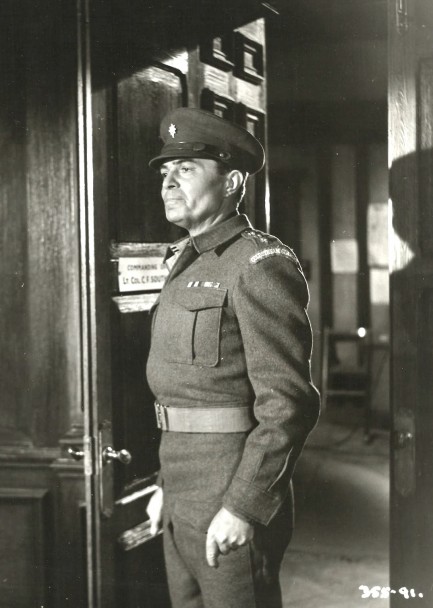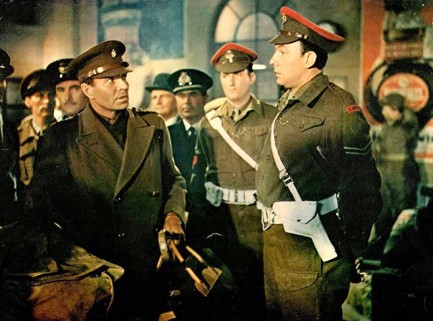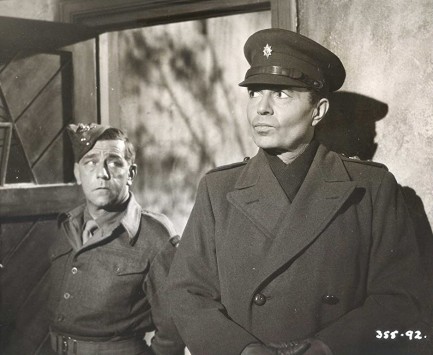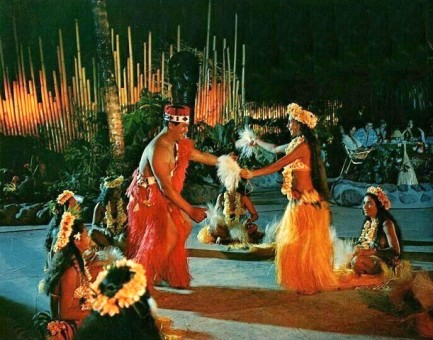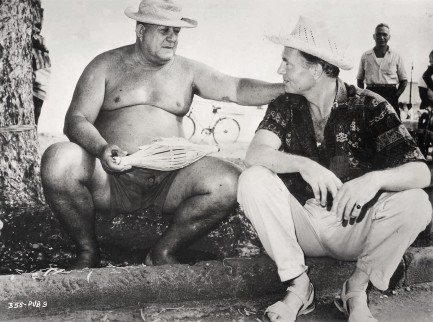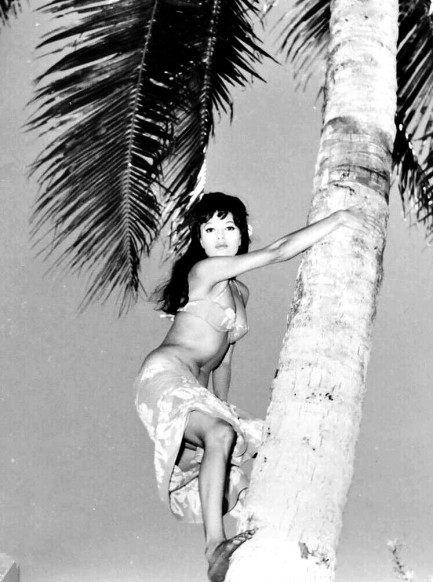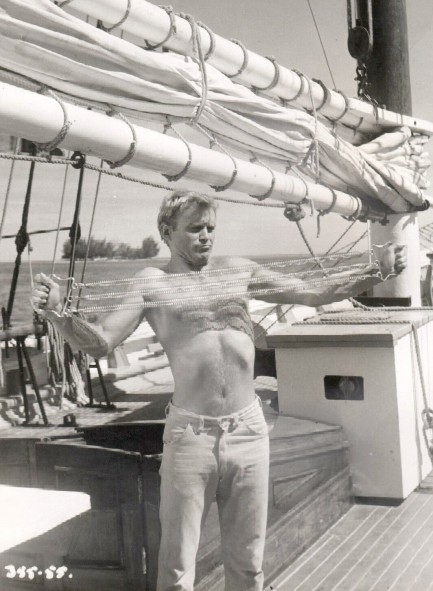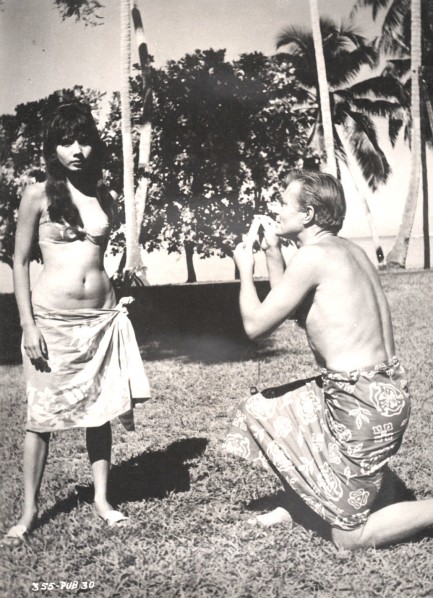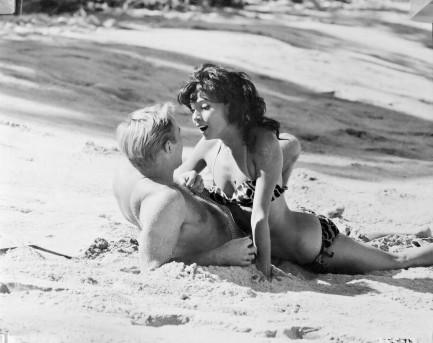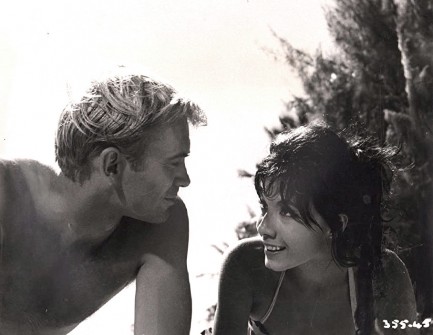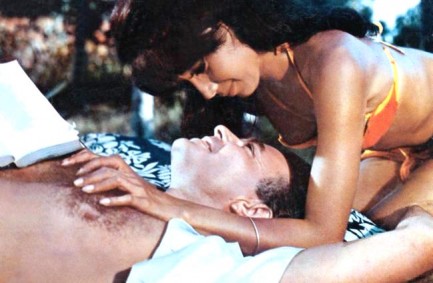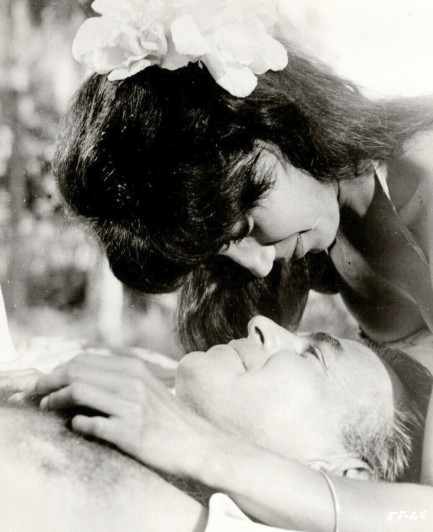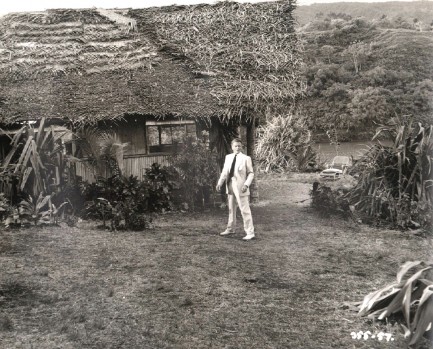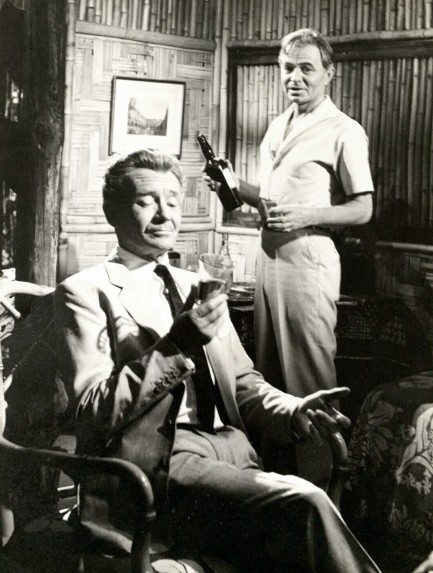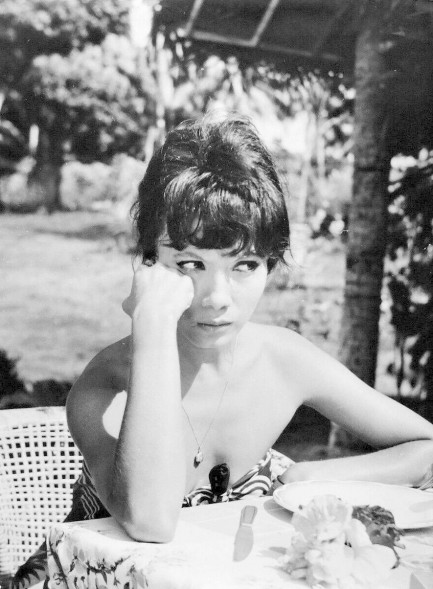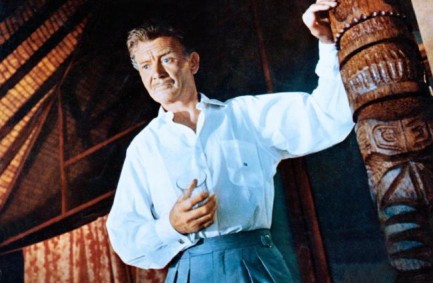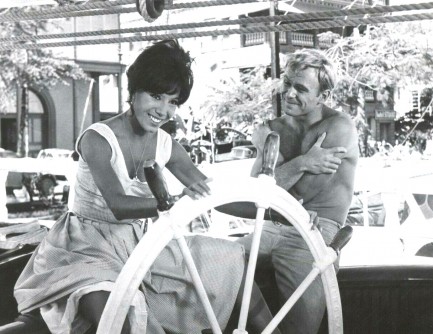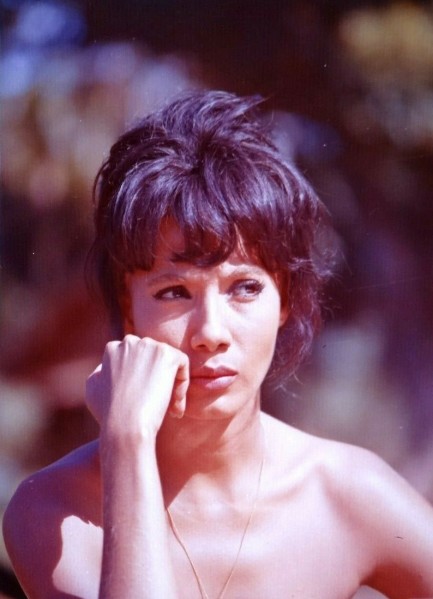 Around the world in 180 pages (or thereabouts). 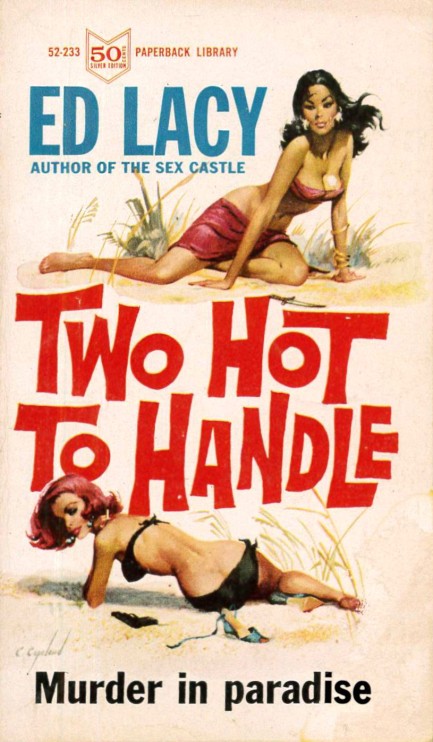
Wouldn't it be great to sail away to an exotic island, live in a hotel, and write novels? Ed Lacy was the archetypal globetrotting author, and 1963's Two Hot To Handle is a product of that lifestyle. It's two novellas joined: “Murder in Paradise,” set in Tahiti, and “The Coin of Adventure,” set on the other side of the planet in Tuscany. “Murder in Paradise” is the tale of an American named Ray Judson and his local wife Ruita, who live reclusively on a small island, and are hired by a Hollywood studio to help scout locations for an adventure movie. Does this idea sound familiar? It should. We guess this sort of thing happened in real life enough to inspire a few novels. Anyway, when the leading lady is murdered the police point the finger at Ruita, and Ray desperately undertakes to find the real killer. We're going to start using the shorthand term “find-the-real-killer novels” to refer to these plotlines. By day Ruita eludes the cops by hiding out on a tiny islet, and by night she ventures ashore to assist her husband and sneak in some moonlit lovin. Avoiding prison is important, but you gotta get your freak on too.
“The Coin of Adventure” is about Kent Kelly, an American adventurer in Viareggio, Italy, who learns that fascists fleeing at the end of World War II abandoned a hoard of stolen gold in a cave. He and a partner head after the loot, but death and betrayal are always uninvited passengers on such missions. Of the two stories we liked “Murder in Paradise” a little better. Lacy, it's clear, strove to correctly portray Tahiti without resorting to travelogue or showy displays of local language. He was interested in the people. To even write a character like Ruita, who decides to work for the moviemakers to ensure that they get the details of her culture correct, shows his empathy for island folk. She's an excellent character—ambitious enough to want to influence how her people are portrayed in Hollywood, naive enough to think she can really do it. With Lacy leading the way we'll go anywhere. Tahiti? Tuscany? You bet.
 James Mason's tropical paradise may not be an accurate portrayal, but you can't say it's not fun. 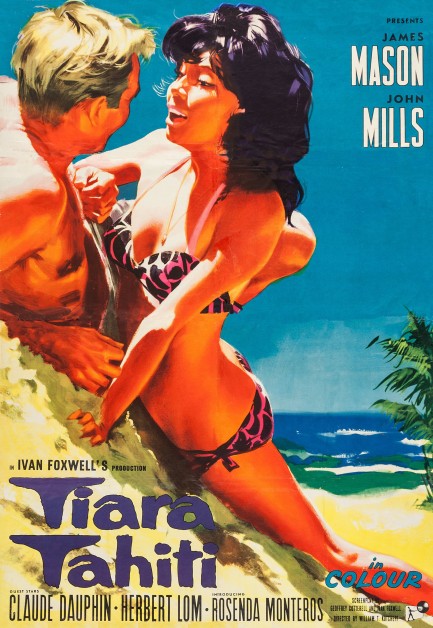
This nice poster was made for the British produced South Seas movie Tiara Tahiti, which opened in the UK today in 1963. There are a few posters but this one is the best, we think, though we had to do some heavy retouching to make it presentable. An alternate promo appears below. The movie is a comedy-drama about former business partners played by James Mason and John Mills, who clashed in England, fought the Germans in World War II, and have both turned up in Tahiti during peacetime. Part of their dislike for each other is due to their opposite personalities. Mills is the uptight sort who wishes to be respected but isn't, while Mason is naturally likeable and happy-go-lucky. One reason for him to be happy is that his girlfriend is Rosenda Monteros. She's supposed to be an island girl, and though she's Mexican in real life rather than Tahitian, she's smoking hot whatever her place of birth.
The movie is based on a novel of the same name by Geoffrey Cotterell, and we're tempted to acquire it. We've gotten pretty good at filling in between the scenes of vintage cinema, and because Monteros is Mason's girlfriend but has flirtatious interactions with other men, we suspect there's an explicitly sexual aspect to the book that was tossed into the screenwriter's garbage bin. We say that because we've read a couple of novels from the mid-century period set in Tahiti, and in both of those local women were portrayed—and we have no way of knowing whether this was true or a white Western fantasy—as readily available. Sex is only hinted at in Tiara Tahiti, but Monteros has a nude scene in a waterfall pool and another topless sequence, and she looks flat-out astonishing in both. We gather these occurred only in the non-U.S. version. Well, try to find that one.
You won't be surprised to learn that there are a few offensive characterizations here, even up to plastering Czech actor Herbert Lom with makeup and prosthetic eyes so he can play a Chinese islander named Chong Sing. There are some who resent this kind of thing being pointed out, but realizing how anachronistic these sorts of elements are isn't different in essence from noting that old vampire movies have bats on strings. It's impossible to look at it and not see it as kind of dumb. There's a better way to do it now, that's all, and that better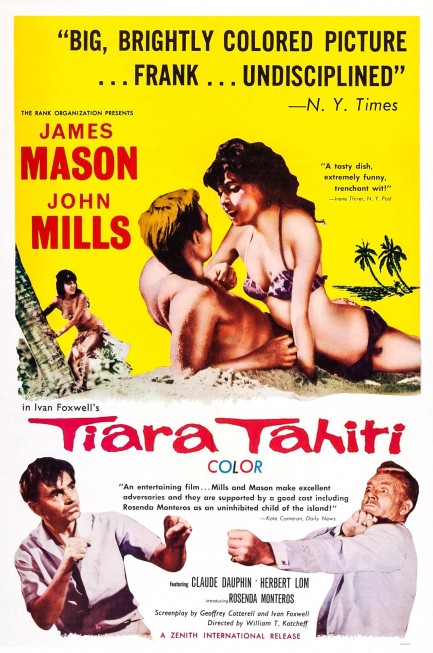 way also offers opportunities in cinema for historically erased groups like the Asian actor who could have played Chong Sing. But movies are still just attempts at entertainment. With notable exceptions like The Birth of a Nation, deliberately harmful portrayals of selected ethnic groups was not a goal. As it happens, Lom is quite good in his role. way also offers opportunities in cinema for historically erased groups like the Asian actor who could have played Chong Sing. But movies are still just attempts at entertainment. With notable exceptions like The Birth of a Nation, deliberately harmful portrayals of selected ethnic groups was not a goal. As it happens, Lom is quite good in his role.
While he and Monteros are important secondary attractions, it's Mason who provides the real reason to watch Tiara Tahiti. He's perfect as the layabout main character—charming, clever, selfish, and always able to improvise when circumstances require it. His old rival Mills is in Tahiti to develop pristine local land for a hotel chain, while Mason is on the opposite side of this paradise-wrecking business deal. He manages to get hired as the project's local expert, but all the while is trying to sabotage the deal from the inside. Of course, Tahiti eventually became dotted with hotels and barely-used millionaire hideaways like everyplace else, and currently is taking steps to reduce mass arrivals from overseas, but within the context of this quaint movie from a lifetime ago, maybe Mason can win. However it turns out, Tiara Tahiti should give you a few smiles.
 Monteros gives a boost to Tahitian tourism. 
The glowing figure you see above is Mexican actress Rosenda Monteros, who appeared in such films as The White Orchid and The Magnificent Seven, and is seen here in a production photo made for the 1962 movie Tiara Tahiti. This really is a beautiful image. Since the movie was actually was filmed mainly in Tahiti, rather than in, like, Long Beach, this shot was doubtless made on the island. A cinema is the closest most people will ever get to that legendary Pacific paradise, but we bet Monteros made plenty of people want to go. We have another nice shot of her below. 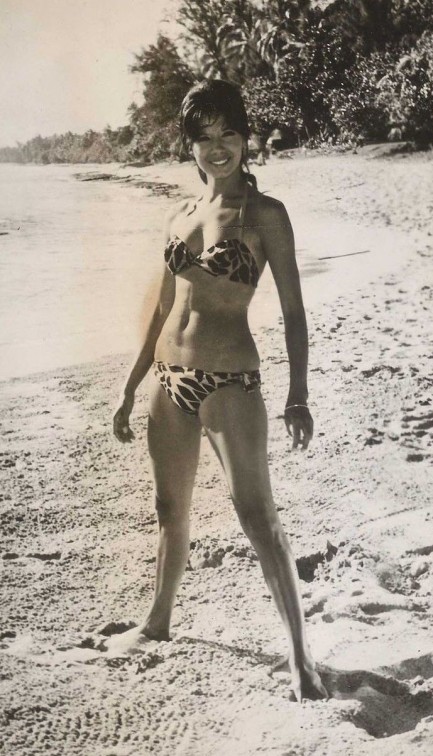
 I told the waiter I left my cash in my room, and he said the drink was on him. What a nice guy! 
Italian actress and television personality Gabriella Farinon relaxes with a cool refreshment in this beautiful shot taken in 1975 on a beach in Mo'orea, Îles de la Société, French Polynesia. Her movies include the vampire flick Et mourir de plaisir, aka Blood & Roses (discussed here), and 1960's Space Men, aka Assignment: Outer Space. We love this shot, not least because it reminds us of our local beach, luckily just a few blocks away. By the time you read this that's where we'll be.
 It doesn't look like much now but wait until it spreads its wings. 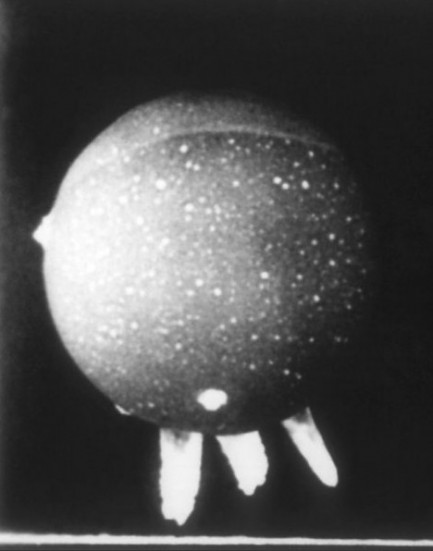
This image shows the first instant of the French nuclear test Pégase, which took place at Mururoa Atoll in French Polynesia today in 1970. Pégase is of course French for Pegasus, but this particular aerial phenomenon isn't something you ride through the sky to perform acts of heroism. The protrusions at the bottom of the plasma ball are wires used to stabilize the testing tower vaporizing, a phenomenon you can see in better detail here and here. You can also see a typical testing tower with wires intact here.
 Mass destruction as a party balloon. 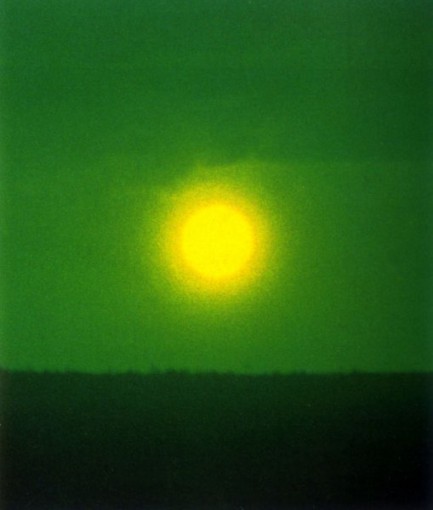
Above is a photo of the French nuclear test codenamed Tamouré, a 50 kiloton airdrop at Mururoa Atoll, Pacific Test Area, French Polynesia. It was the first time the French dropped a nuclear device from an airplane. The photo has the same weird ass green color as the Betelgeuse test we showed you a few years ago, but we don’t know why that is. Exposure time? Film stock? French photog getting all artistic trying make the horrifying reality of the shot a bit more cheerful? We don’t know. But the image was made this week in 1966.
 But wait—doesn’t the sun rise in the east? 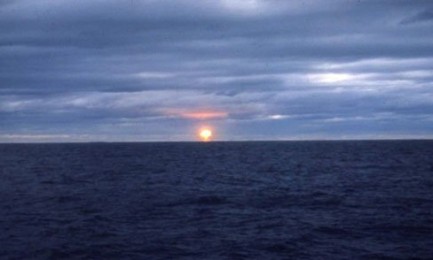
We shared an interesting photo of the French nuclear test Canopus a few years ago, and today we have another image showing the blast from many miles away. Even more than the numerous close quarters photos we’ve posted here, this really shows the titanic and awful power of the weapons that may eventually destroy us.
 Doing it the French way. 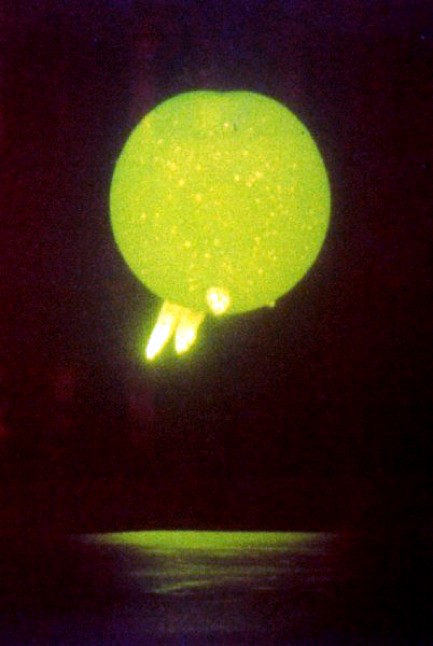
Above, an eerie shot of the French nuclear test Betelgeuse, one of more than two-hundred tests conducted by France over the course of thirty-six years. This one is from 1966, and took place on September 11, but we posted it today rather than in September because it’s incorrectly listed on many websites as occurring today. The location is French Polynesia and the event was strongly protested by the potentially downwind nations of New Zealand, Australia, and Japan, but those complaints were ignored. This exposure was made near the instant of detonation, and the brightly lit protrusions are stabilizing wires attached to the bomb platform vaporizing. You can see a better example of the same phenomenon here.
 Wrong place, wrong time, same result. 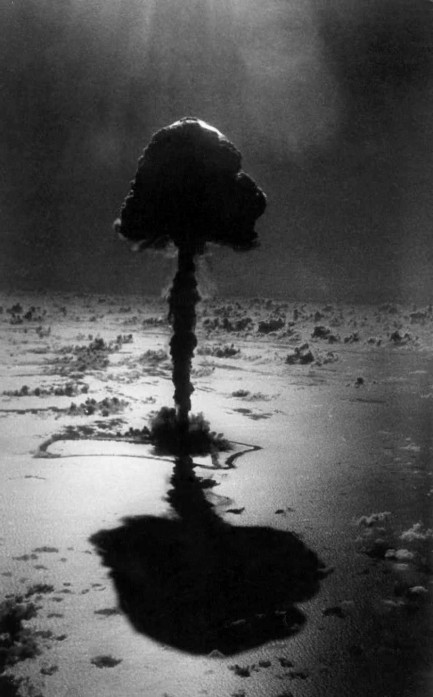
This is the mushroom cloud generated by the French nuclear test Canopus, detonated at Fangataufa Atoll, located in the Tuamotu Archipelago, part of French Polynesia. The blast occurred today in 1968, and if you happen to search for images of the explosion online you will probably not find the one above. What you will find is many photos of the Licorne burst from Mururoa Atoll, 1970. But they are all wrongly attributed. How do we know? See here. And if you’re inclined, you can watch a film of the Canopus explosion here. We rarely explain anything about Pulp Intl., preferring instead to let you wander through the nearly 1,800 scattered posts the same way you might wander through the clutter of a used bookstore. But today we’re making an exception, because while searching the internet for Canopus images we came across a site—which we won’t soil our webpage by naming—that was populated by the most depraved sub-humans we’ve encountered online in a long time. It was a forum, and on this forum the participants unanimously agreed that either Mecca or Teheran—or both—should be nuked. Reading these idiotic tirades, it occurred to us that an occasional visitor to Pulp Intl. might see our nuke postings as some sort of endorsement of their existence or usage. So for the record, we think nuclear weapons are self-evidently bad, but we post these explosions because, from Hiroshima to Kiss Me Deadly to Harlan Ellison, they are an inextricable part of the pulp and post-pulp eras.
 Silly boys. I wonder if they'd be fighting if they knew that no matter who wins I'm going to lei them both. 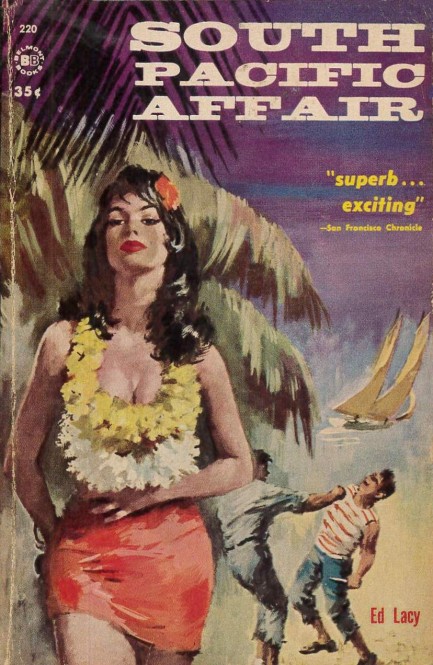
This cover for Ed Lacy's 1960 novel South Pacific Affair makes us suspect artist George Ziel was thinking along the same lines as us—i.e. it's interesting that he painted the island woman with two leis around her neck. Here's a fun fact: while we know several people, us included, who've come to the physical defense of women in danger, we don't know a single man who's ever fought due to romantic rivalry. We asked around. Nobody admitted to it. Is it generational? Every woman we know would stop this fight in its tracks with: “Hey! Idiots! I'm not a 24-pack of Coors! I choose, and it's neither of you!” But the cover misleads, as they sometimes do. There's no literal fight over a woman. There's a fight over a sexual betrayal, but the catalyst is years in the past and 7,000 miles away.
We've read a few Ed Lacy books, and all of them have been about crime and graft in urban settings. South Pacific Affair expands his field of interests to the classic fantasy of life in paradise. Ray Jundson is an American living on the fictional French Polynesian island of Numaga who can't see the beauty of his circumstances. He's torn between staying there, continuing to sail from island to island trading goods, and marrying his island sweetheart Ruita, or letting his wanderlust and desire for riches carry him away toward unknown solo adventures, possibly even back to the U.S. Frankly, for a man with everything he's way too jaded for realism, but you have to follow the author's lead.
We don't know if Lacy ever went to French Polynesia, but the details read as if he did. That's good, because other than travelogue, nudity, and a lot of soul searching by Ray, nothing much happens in the book until, more than halfway through, a smallpox outbreak brings on a countrywide quarantine. One captain defies the law, sails from Papeete to Numaga, and tries to offload passengers, while downplaying the severity of the disease. That's on-the-nose for 2020, don't you think? Turns out he's actually trying to jettison a group of advanced cases and Ray is one of the people fate places in a position to stop this deadly maneuver.
This is Ray's first motivated act in the entire book, but fortunately not his last, which means the final third of the story gets interesting. Too bad that newly found motivation leads him to set up a scam involving a fake Polynesian princess, credulous American tourists, and the island equivalent of pimping. It may sound farfetched, but we can tell you from personal experience: spend enough time on a tropical island and anything can seem like a good idea. South Pacific Affair isn't Lacy at his best, but for knockaround guys like us, it was pleasantly familiar. Overall, we think it's worth reading for its unusual status in the Lacy bibliography. But we offer no guarantees.

|
 |

The headlines that mattered yesteryear.
2003—Hope Dies
Film legend Bob Hope dies of pneumonia two months after celebrating his 100th birthday. 1945—Churchill Given the Sack
In spite of admiring Winston Churchill as a great wartime leader, Britons elect
Clement Attlee the nation's new prime minister in a sweeping victory for the Labour Party over the Conservatives. 1952—Evita Peron Dies
Eva Duarte de Peron, aka Evita, wife of the president of the Argentine Republic, dies from cancer at age 33. Evita had brought the working classes into a position of political power never witnessed before, but was hated by the nation's powerful military class. She is lain to rest in Milan, Italy in a secret grave under a nun's name, but is eventually returned to Argentina for reburial beside her husband in 1974. 1943—Mussolini Calls It Quits
Italian dictator Benito Mussolini steps down as head of the armed forces and the government. It soon becomes clear that Il Duce did not relinquish power voluntarily, but was forced to resign after former Fascist colleagues turned against him. He is later installed by Germany as leader of the Italian Social Republic in the north of the country, but is killed by partisans in 1945.
|

|
|

It's easy. We have an uploader that makes it a snap. Use it to submit your art, text, header, and subhead. Your post can be funny, serious, or anything in between, as long as it's vintage pulp. You'll get a byline and experience the fleeting pride of free authorship. We'll edit your post for typos, but the rest is up to you. Click here to give us your best shot.

|
|




 way also offers opportunities in cinema for historically erased groups like the Asian actor who could have played Chong Sing. But movies are still just attempts at entertainment. With notable exceptions like The Birth of a Nation, deliberately harmful portrayals of selected ethnic groups was not a goal. As it happens, Lom is quite good in his role.
way also offers opportunities in cinema for historically erased groups like the Asian actor who could have played Chong Sing. But movies are still just attempts at entertainment. With notable exceptions like The Birth of a Nation, deliberately harmful portrayals of selected ethnic groups was not a goal. As it happens, Lom is quite good in his role.